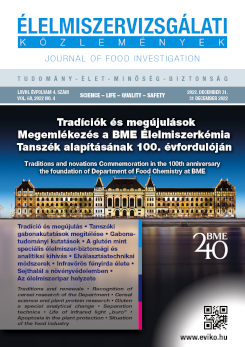Recent past, present and hoped-for future of cereal science and plant protein research
Main Article Content
Absztrakt
The fields of science indicated in the title represent centuries old research and development activities of the current department and its legal predecessor institutions, matching the standards, expectations and possibilities of the given era. It is of course impossible to summarize all this in a few pages. A tangential or more detailed description of some areas can be found in other chapters of this issue compiled to review the scientific activities of the department (e.g., in the articles of András Salgó and Ferenc Békés, Zsuzsanna Bugyi et al., Eszter Schallet al.) and in the summary article presenting the department’s food science activities [1]. In our current paper, we attempt to provide a brief overview of research directions and results that, from the 1990s to the present day, have played a decisive role in the activities of the department, including the Cereal Science and Food Quality Research Group, as well as in the development and shaping of its research profile.
The years following the regime change were decisive in the lives of all of us. The conditions for education and the cultivation of science changed continuously and significantly, mostly worsening in this transition period. Many people questioned whether it was worth continuing to cultivate the old, traditional areas, or whether we should be more open, modernize and look for new ways, taking advantage of the extremely slow but continuously opening opportunities for building domestic and, especially, international relations, and later for tenders and financing. Progress, development, and openness to new ideas should be essential qualities for an educator and researcher. However, the acquisition of knowledge, experience, and skills takes time, as does the creation and maintenance of the conditions necessary for the cultivation of old or new fields. In this uncertain operating matrix, in the mid-1990s we decided to move towards new areas (modernization of food analysis, automatic and rapid test methods, food safety), while trying to maintain and strengthen the cultivation of traditional fields (such as research related to cereal science and plant proteins, development of analytical methods and instruments) that had gained national and international recognition thanks to the work of our predecessors [1].
In the following sections, a brief summary of grain qualification and related method and instrument developments enabling the examination of typically small amounts of material, research on the qualification of small and pseudocereals and improving their possibilities of use, as well as analytical and product development results for increasing food safety, partially related to the previous topic, is given.

